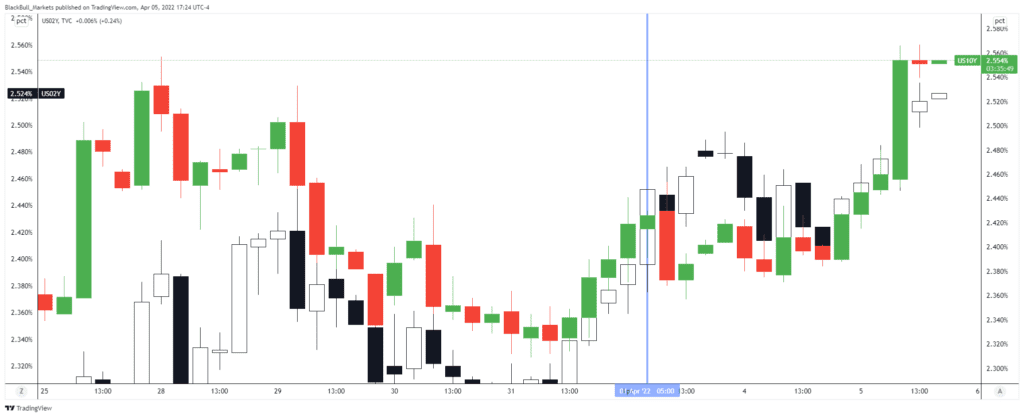Worries of a looming recession intensified late Thursday last week after the yield on the United States 2-Year Treasury bonds hit 2.337% as the yield on United States 10-Year bonds fell to 2.331%, marking an inversion that usually preceded previous periods recessions.

It was the first negative spread since 2019. However, Treasury yields flipped again on Apr. 1 and again on Apr. 4, when the two-year yield rose to 2.453% against a 10-yield which hiked to 2.432%.
An inverted bond yield shows that financial conditions are tight and could also signal a looming downturn. Under normal circumstances, the yield curve is not inverted since debt with longer maturities typically carries higher interest rates than nearer-term ones.
Considering that every recession since 1955 was preceded by an inversion in the yield curve for US bonds, its recent and more frequent occurrence surely does not alleviate concerns in the market, especially when it remains on high alert for the economic implications of Russia's military attacks against Ukraine and the growing inflation in the US.
Bond Yields as Recession Markers
According to a 2018 report by researchers at the Federal Reserve Bank of San Francisco, each recession since 1955 followed the inversion of the US yield curve between 6 and 24 months.
The 10-year to two-year Treasury spread provided a false positive to a recession in the mid-1960s. That instance did not deter economic officials from looking into bond yields when checking for signs of an impending recession.
On Aug. 28, 2019, the yield on two-year bonds briefly surpassed the yield for its 10-year counterpart. This negative turn of the spread predated the two-month recession that started in February 2020, which also happened amid the outbreak of the Covid-19 pandemic.

Before that, Treasury yields flipped for most of 2006. Nearing the end of the following year, the Great Recession happened and lasted until June 2009, marking the longest recession since World War II.
Not the Only Indicator
While bond yield inversion has been a reliable indicator of recessions in the past, it is not the only factor that could tell another period of significant, widespread, and extended economic decline is approaching. More importantly, even if they do predate a recession, an inverted bond yield is not the reason why it happened.
The bond market's performance is only one of many factors that affect the direction of the economy. The recent movement of the yields of both short- and long-term US Treasury bonds could indicate how the market expects regulators to respond to global events and economic trends.
Increasing yields of short-term US government debt reflect expectations of a series of rate hikes by the Fed. Meanwhile, the slower pace of growth in the yields of longer-dated government bonds happens amid concerns that policy tightening may be hurting the economy.
Nevertheless, expect market watchers to look closely into bond yields over the next few months. Economic officials will likely do the same because if past recessions taught us anything, it is best to treat these indicators with caution and still have plans to ensure that even if a recession materializes, its impacts on the economy will be lessened as much as possible.
